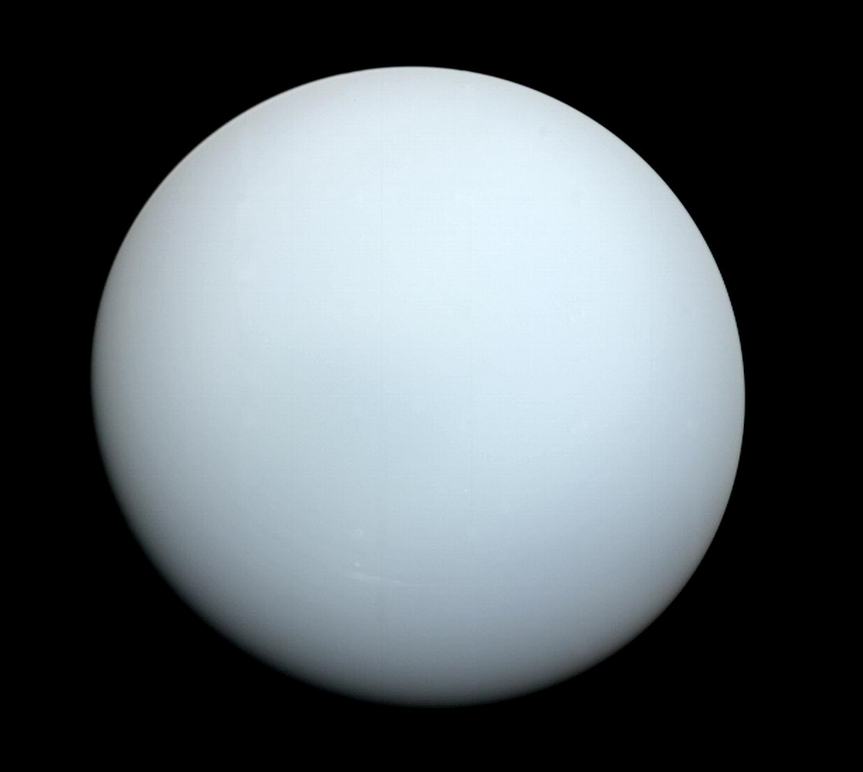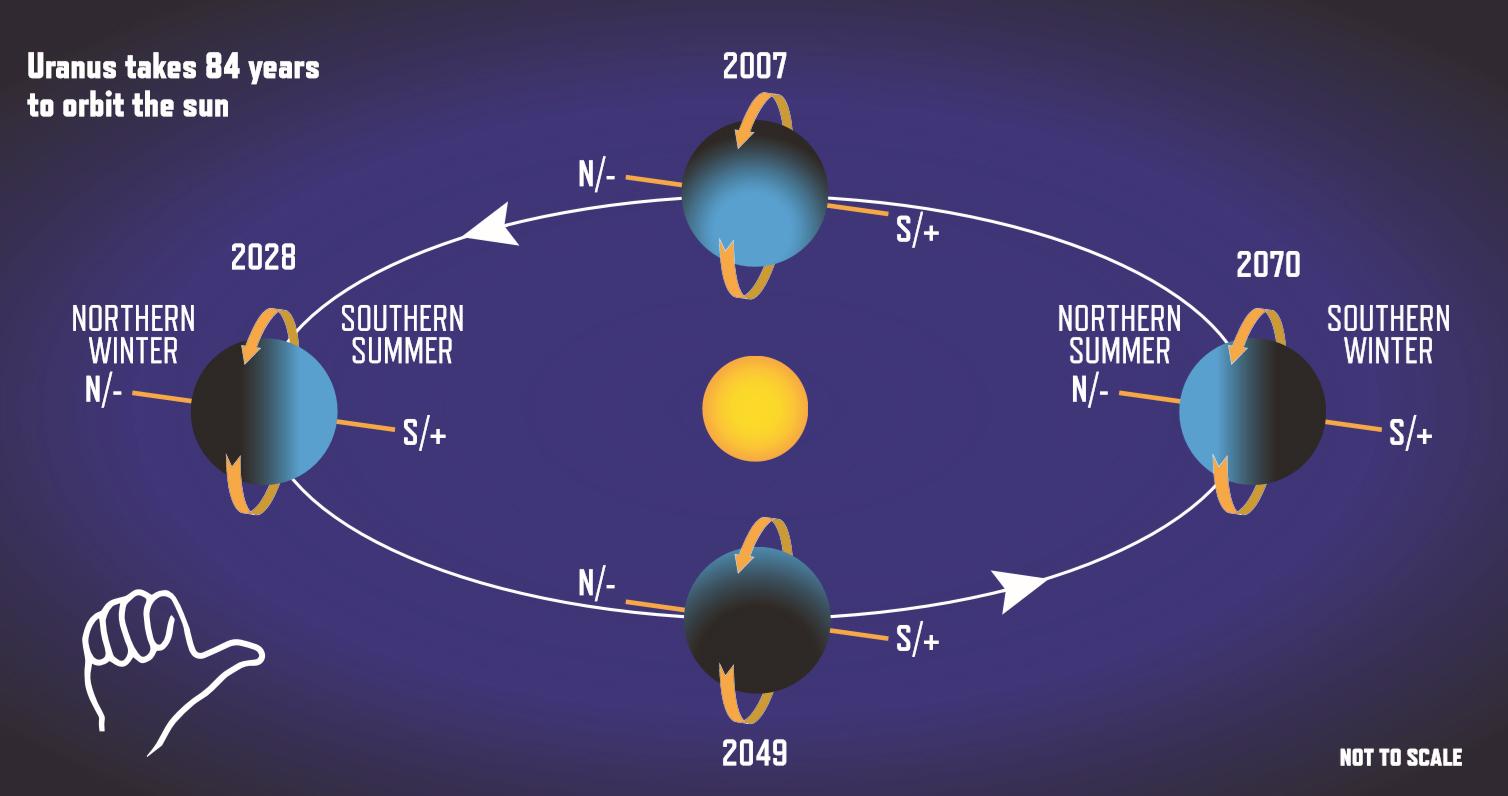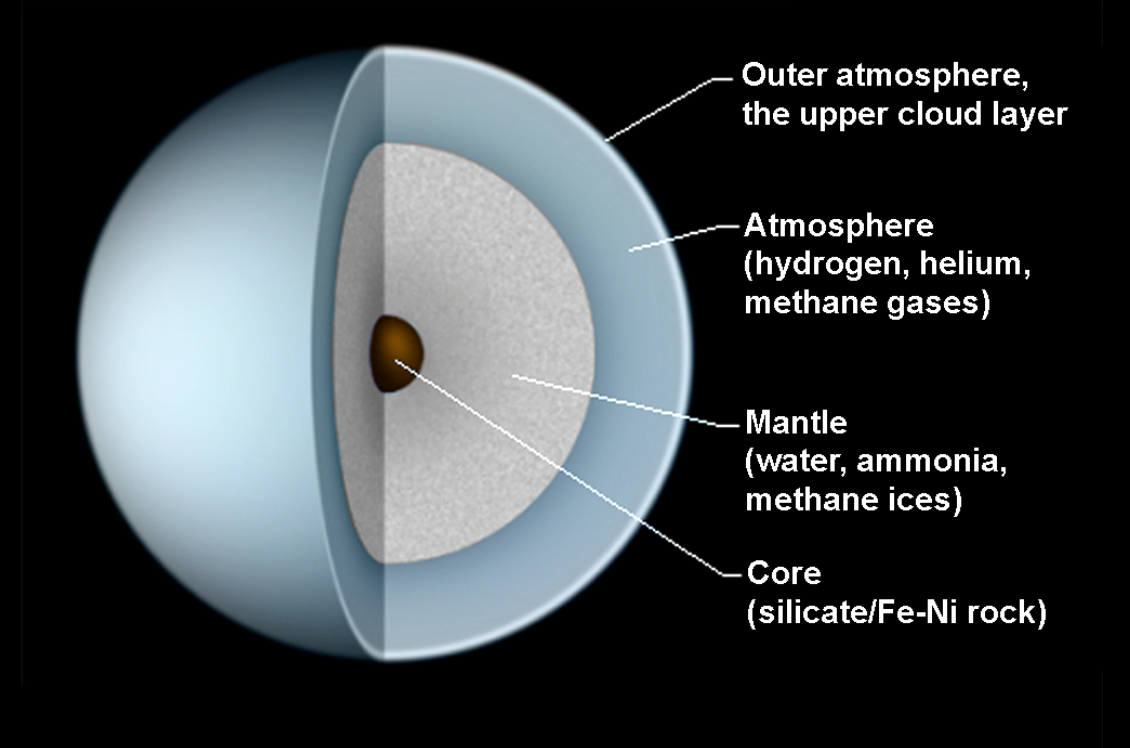
It only takes a glimpse into the night sky to realize our closest neighbor is the Moon, our own natural satellite. Traveling a distance of roughly 240,000 miles (386,400 kilometers) it takes around 3 days to make a one way journey to the Moon. The planets of our solar system are much further away some more so than others so planets like Uranus take a while to reach.
What Is Uranus?
Uranus is a gaseous cyan ice giant planet which is the seventh from the Sun in our solar system. It is the third largest planet in the solar system and has a unique 90-degree rotation angle which makes it appear to be spinning sideways. This gives the effect of it rolling like a ball as it orbits the Sun.
How Far Is Uranus from Earth?
In 1977 the launch of Voyager 2 happened and took around 9 years to reach its close pass with Uranus which should give you an indication of how far away the planet is from Earth. Uranus is roughly 1.8169 billion miles away from Earth.
How Far Is Uranus from the Sun?
The distance from the Sun to the planet Earth equates to a unit of measurement known as astronomical units (AU). Uranus is around 19.8 AU from the Sun which roughly equates to an average distance of 1.8 billion miles (2.9 billion kilometers).
How Long Does Uranus Take to Go Around the Sun?
The seventh planet from the Sun, Uranus has a sizable orbital period. Spinning faster in its orbit than planet Earth a day on Uranus lasts 17 Earth hours and because of its vast orbital distance it takes 30,687 Earth days to travel around the Sun. With a Uranian year lasting 84 Earth years the last time this planet was in the same region of space as it is in 2023 certain events were taking place such as:
- The Second World War begins after growing tensions with Germany
- The Spanish Civil War comes to an end
- Pope Pius XI dies
- Sir Ian Mckellen the English actor was born

The combination of a Uranian year lasting 84 years and a shorter day added to a 97.77 tilt on its axis means that the planet’s polar regions can see 21-year-long dark winters at the poles.
What Is an Ice Giant Planet?
Ice giants are massive planets composed mainly of elements heavier than hydrogen and helium. These might include oxygen, carbon, nitrogen and sulfur. Our solar system is home to two ice giants, Neptune and Uranus.
Ice giants form when gravity pulls together swirling gas and dust. They may form closer to a star but migrate further away over time becoming colder as they go. They usually have a smaller rocky core with most of their mass being made up of materials such as water, methane and ammonia.
Uranus’ Structure
With an impressive mass roughly 14.5 times that of Earth’s, Uranus’ exact mass of ice in its interior is not known. Unlike standard gas giants Uranus’ composition seems to consist of only a small amount of hydrogen and helium comparatively speaking. Its mantle is mainly made up of water, ammonia and methane in ice form. The core of the planet is thought to be made up of a dense rock which may be comprised of a nickel-iron silicate.

The extreme pressures and heat deep in the planet are believed to break up methane molecules with carbon atoms leading to condensation into crystals that rain down through the mantle as hailstones. Experiments at the Lawrence Livermore National Laboratory suggest that the mantle may comprise an ocean of metallic liquid carbon.
Surface
Uranus does not have a surface to speak of, at least not one that a spacecraft could land upon. The planet is mostly swirling fluids so it has no solid surface upon which to land. Even if there were a surface a craft could not reach it due to Uranus’ atmosphere
Atmosphere
Comprising mostly hydrogen and helium, the atmosphere of Uranus because extreme pressures and temperatures would destroy a metal spacecraft. The presence of methane, ammonia and water in the atmosphere help create the blue appearance of the planet.
Magnetosphere
A planet’s magnetic field is usually inline with its rotation but this is not the case on Uranus. Its magnetic axis is tilted nearly 60 degrees from the planet’s axis of rotation. Additionally it is also offset from the center of the planet by one-third of the planet’s radius.
Does Uranus Have Moons and Rings?
The planet Uranus has at present 27 known moons most of which are named for characters from the works of William Shakespeare and Alexander Pope. This goes against the tradition of other planets’ moons which are usually named based on Greek and Roman mythological characters.
It was Sir William Herschel who discovered the first two moons of Uranus, Titania and Oberon, which he spotted on January 11, 1787, roughly six years after he had discovered the planet itself. It would be half a century before telescope technology improved enough to start seeing some of the planet’s other moons.
Saturn is probably the most famous planet with rings but Uranus also has some of its own. It in fact has two sets. The inner system consists of nine rings that are mostly narrow and dark grey in color. The outer two rings are different with the innermost being a reddish color and the outermost appearing blue.
The rings in order of distance from the planet are named Zeta, 6, 5, 4, Alpha, Beta, Eta, Gamma, Delta, Lambda, Epsilon, Nu, and Mu. Several of the larger rings are also surrounded by belts of fine dust. It was again William Hershel who in his continued observations of Uranus determined there may be rings around Uranus. In his journal he noted on February 22, 1789 “A ring was suspected.” He accompanied this with a sketch and noted that it appeared reddish in color.
History of the Observation of Uranus
Despite barely being visible from Earth with the naked eye Uranus was visible to the astronomers of the ancient world. Unlike some closer planets to Earth however, these astronomers did not realize at the time that it was a planet. This is because of its dimness and slow orbit. The assumption was made that it was in fact a distant star.
It was Sir William Herschel who first used a telescope to get a better look at Uranus in 1781 although initially he thought it may still be a star or perhaps a comet. Two years later it was the further observations of astronomer Johann Elert Bode that confirmed Uranus as a planet.

Herschel wrote of his observations after making them in his home garden. He wrote in his notes “In the quartile near Tauri … either [a] Nebulous star or perhaps a comet.” Just four days later he updated his observations by noting “I looked for the comet or nebulous star and found that it is a comet, for it has changed its place.”
His findings were submitted to the Royal Society with the assertion that he had found a new comet although there was implicit indication that it may be a planet. Hershel was convinced his find was a comet but other astronomers were already working to the assumption it was more likely a planet.
Space Exploration of Uranus
In 1977 the United States launched Voyager 2 with the intention of reaching Uranus. On the 24th of January 1986 it passed by Uranus within 81,500 kilometers of the cloud tops. In its past it made studies of the structure and chemical composition of the planet’s atmosphere. Special interest was focused on its weather conditions due to the planet’s unique rotation.
Voyager 2 also made in depth studies of its five largest moons and discovered a further 10 new ones. It also studied the planet’s nine known rings and discovered two more that were not previously observed. This so far has been the only flyby of Uranus by terrestrial spacecraft. Several other missions have been suggested but have not made it beyond early planning stages.
How Long Does It Take to Get to Uranus?
Thanks to the Voyager 2 mission we have a real world example of how long a journey to Uranus takes. This mission was a flyby so it was done in the quickest way possible but still took 9.5 years to pass close to the planet.
As yet no mission has been planned to place a spacecraft in Uranus’s orbit so we don’t know how long this would take. We can be certain however that it would take far longer than a flyby because it has to travel much slower to be captured into the planet’s orbit.
Final Thoughts
The Journey to Uranus takes years rather than months so this is definitely not a target for a human flown spacecraft to visit. It would take the better part of a decade to make the journey and once reached Uranus would not be a hospitable planet to explore.
